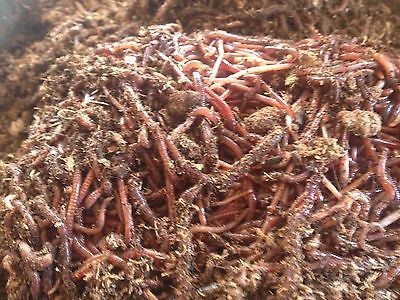Eco-conscious red worms: Ways to maximize results
Eco-conscious red worms: Ways to maximize results
Blog Article
Everything You Required to Learn About Red Wigglers for Composting
Red wigglers, or Eisenia fetida, play a pivotal function in the realm of composting, changing organic waste right into important soil modifications. The process of establishing up a worm bin and preserving it can position difficulties.
What Are Red Wigglers?

(red worms for sale)
Indigenous to North America, red wigglers are surface-dwelling organisms that like wet, cozy environments abundant in disintegrating organic matter. Their diet consists largely of decomposing plant material, food scraps, and various other natural particles, which they take in and damage down effectively. As they absorb this product, they create nutrient-rich spreadings that boost soil fertility.
Red wigglers are hermaphroditic, having both male and women reproductive organs, and can reproduce swiftly under ideal problems. On the whole, red wigglers are important factors to the procedure of reusing natural waste into useful garden compost.
Advantages of Using Red Wigglers
Using red wigglers in composting systems uses many benefits that boost both the performance of waste management and the quality of the resulting garden compost. These worms, clinically recognized as Eisenia fetida, are specifically efficient at damaging down raw material, transforming cooking area scraps and lawn waste right into nutrient-rich compost at an increased price.
One of the primary advantages of making use of red wigglers is their capability to consume big amounts of organic material, typically refining their weight in food waste daily. This high usage rate leads to much faster disintegration and decreases the quantity of waste sent to landfills. The castings created by red wigglers are rich in necessary nutrients, useful microbes, and enzymes, making them an outstanding fertilizer for gardens and plants.
Furthermore, red wigglers thrive in a variety of atmospheres, making them versatile for both interior and exterior composting systems - red wigglers. Their presence in a garden compost bin aids to freshen the product, avoiding smells and promoting a healthy and balanced composting procedure. In general, utilizing red wigglers not only adds to reliable waste administration yet likewise supports lasting horticulture methods via the production of top quality compost
(NC Worm Farms)
Establishing Your Worm Bin
To effectively establish a worm container, it is essential to select a suitable container that satisfies the demands of red wigglers while supplying a favorable atmosphere for composting. An ideal container can be made from plastic, timber, or steel, with a capacity of a minimum of 1 square foot for each pound of worms.
Make sure the container has sufficient drainage holes to stop excess moisture, as red wigglers flourish in a damp, however not water logged, setting. red wigglers. The bin should also be ventilated to provide enough air movement, protecting against anaerobic problems that might harm the worms
A perfect area for the worm container is an awesome, dark location, without straight sunlight and severe temperature levels, as red wigglers favor a temperature level variety of 55 to 77 degrees Fahrenheit.
Prior to presenting the worms, prepare bed linen products such as shredded newspaper, cardboard, or coconut coir, which will provide both environment and food. Moisten the bed linens gently to develop an inviting setting for the worms. Think about putting a cover on the container to maintain moisture and lower pests, while ensuring it can be conveniently gotten rid of for upkeep.
Feeding and Treatment Standards
Feeding red wigglers is a critical facet of keeping a healthy and balanced composting system. These worms flourish on a varied diet regimen, mainly composed of organic products such as vegetables and fruit scraps, coffee grounds, and crushed eggshells. It is vital to prevent feeding them meat, dairy products, and oily foods, as these can develop undesirable odors and draw in parasites.
When presenting food to your worm bin, cut or shred products into smaller pieces to help with quicker decay. Start with percentages to gauge the worms' usage rate, slowly boosting the amount as they adapt. It is a good idea to page alternative feeding places within the bin to encourage complete blending and aeration of the garden compost.

Troubleshooting Common Issues
Maintaining a flourishing worm composting system can sometimes offer challenges that require focus and troubleshooting. Common problems include an undesirable smell, which typically suggests overfeeding or the visibility of anaerobic problems. To remedy this, reduce the amount of food included and ensure correct oygenation by blending the bed linen material.
Another frequent problem is the getaway of worms from the bin. This can take place due to extreme dampness or inappropriate environmental problems. Routinely check the dampness levels, going for a wet yet not soggy consistency, and preserve ideal temperature levels in between 60-80 ° F(15-27 ° C )to produce a comfortable habitat for your red wigglers.
Bugs, such as fruit flies, can likewise attack worm bins. red wigglers. To combat this, cover food scraps with a layer of bed linens or shredded paper to discourage flies from laying eggs. Additionally, ensure that any type of food included is fresh and devoid of mold and mildew, which can draw in undesirable insects
Last but not least, if your worms appear non-active, inspect for stress variables such as temperature changes or insufficient dampness. Resolving these usual problems will certainly assist preserve a healthy and efficient worm composting system.
Final Thought
In recap, red wigglers, or Eisenia fetida, play a crucial function in sustainable waste management via vermicomposting. Their capacity to effectively transform organic waste into nutrient-dense castings improves soil health and advertises plant development. Correct configuration and upkeep of a worm container, in addition to adherence to feeding guidelines, ensure a successful environment that lessens landfill payments. Attending to common issues without delay better sustains the performance of this environmental technique, adding to ecological sustainability and agricultural productivity.
Report this page